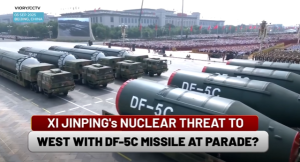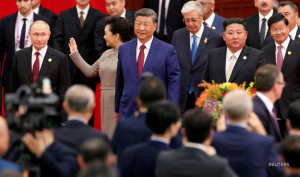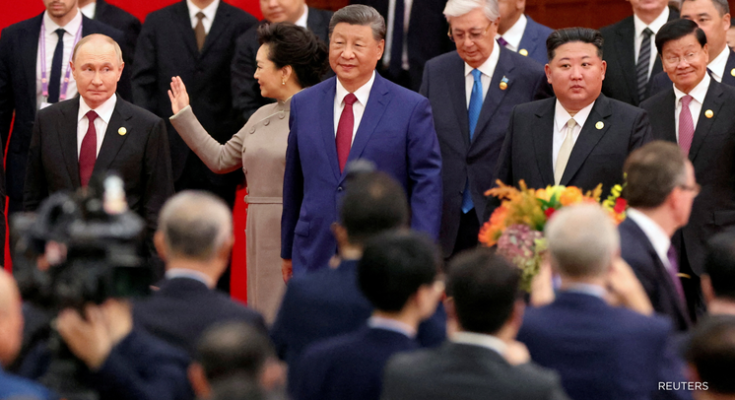 The Parade of Power: Xi Jinping’s Grand Display with Putin and Kim
The Parade of Power: Xi Jinping’s Grand Display with Putin and Kim
On September 3, 2025, the heart of Beijing pulsed with orchestrated precision and thunderous symbolism. Tiananmen Square, the historic epicenter of China’s revolutionary past, transformed into a stage for one of the most visually arresting and politically charged spectacles in recent memory—a military parade that was not merely a commemoration of World War II’s end, but a declaration of China’s place in the global order.
At the center of it all stood Chinese President Xi Jinping, flanked by Russian President Vladimir Putin and North Korean Supreme Leader Kim Jong Un. The trio, each a figure of defiance against Western hegemony, presented a tableau of unity that sent ripples across diplomatic circles and ignited fierce debate around the world.
🎖️ A Choreographed Assertion of Strength
The parade marked the 80th anniversary of Japan’s surrender in World War II—a moment of historical gravity for China, which suffered immense losses during the war. But this was no ordinary remembrance. With over 10,000 troops, cutting-edge weaponry, and aerial displays that painted the sky with national pride, the event was a meticulously choreographed assertion of military might.
Xi Jinping, dressed in a grey Mao-style suit, reviewed the troops from an open-top limousine, saluting formations of soldiers and rows of DF-5C intercontinental ballistic missiles—capable of delivering nuclear payloads across continents. Fighter jets, hypersonic missiles, underwater drones, and jamming aircraft paraded past the grandstands, showcasing China’s technological leap in warfare.
The message was unmistakable: China is not only remembering its past but redefining its future.
🌐 The Axis of Upheaval
The presence of Putin and Kim was no mere diplomatic courtesy—it was a deliberate signal. Both leaders, isolated by Western sanctions and criticism, stood shoulder to shoulder with Xi, forming what some commentators dubbed an “Axis of Upheaval”. Their attendance underscored a growing alignment among nations that challenge the U.S.-led global order.
Putin, embroiled in a prolonged war in Ukraine, and Kim, whose nuclear ambitions continue to provoke international concern, were not just guests—they were co-authors of a new narrative. One that positions China as a stabilizing force among revisionist powers, offering an alternative to Western alliances.
Xi’s speech echoed this sentiment. “Humanity is again faced with a choice of peace or war, dialogue or confrontation,” he declared, emphasizing China’s commitment to peaceful development while subtly rebuking what he called “bullying behavior” from unnamed nations.
🧠 Rewriting History, Reframing Power
The parade also served a subtler purpose: historical reframing. By commemorating the end of World War II with such grandeur, Xi sought to elevate China’s role in the global victory over fascism—a narrative often dominated by Western powers. In doing so, he reinforced the ideological foundation of the Chinese Communist Party: that China rose from humiliation to strength through unity, sacrifice, and resistance.
This reframing is central to Xi’s doctrine of national rejuvenation. The parade wasn’t just about military prowess—it was about reclaiming historical agency and asserting that China’s rise is both righteous and irreversible.
🕊️ The Absence That Spoke Volumes
Notably absent from the parade were Western leaders. The United States, Japan, and most European nations declined to attend, citing concerns over the presence of Putin and Kim. Their absence created a vacuum that China filled with its own narrative—one of solidarity among non-Western nations and defiance against perceived Western hypocrisy.
Former U.S. President Donald Trump, watching from afar, offered a mix of formal congratulations and pointed accusations. “Please give my warmest regards to Vladimir Putin, and Kim Jong Un, as you conspire against The United States of America,” he posted on Truth Social. His remarks, though laced with sarcasm, reflected the unease in Washington over the growing camaraderie among these leaders.
🔍 Symbolism in Every Detail
Every element of the parade was steeped in symbolism. The red carpet walk by Xi, Putin, and Kim. The synchronized salutes. The release of balloons and patriotic songs sung by choirs of thousands. Even Xi’s choice of attire—a nod to Mao Zedong—was a deliberate invocation of revolutionary legacy.
The parade route itself, along Chang’an Avenue and through Tiananmen Square, traced the path of China’s political evolution—from imperial rule to communist revolution to global superpower. It was a visual narrative of continuity and transformation.
🧭 Strategic Messaging to the World
Beyond the spectacle, the parade was a strategic communication tool. It allowed China to:
- Reaffirm its military capabilities in the face of rising tensions in the South China Sea and Taiwan Strait.
- Strengthen diplomatic ties with Russia and North Korea, signaling a multipolar shift in global alliances.
- Project internal stability amid economic challenges and demographic shifts.
- Reassert ideological confidence, positioning the Chinese model as a viable alternative to Western liberalism.
Xi’s message was clear: China is not just participating in global affairs—it is shaping them.
💬 The Emotional Undercurrent
For many Chinese citizens, the parade stirred deep emotions. It was a moment of pride, remembrance, and affirmation. The sacrifices of ancestors were honored, the strength of the nation celebrated, and the promise of a powerful future reaffirmed.
But for others—especially in neighboring countries and the West—it was a moment of anxiety. The display of nuclear-capable missiles, the presence of controversial leaders, and the absence of Western voices raised questions about the direction of global diplomacy.
Is this the dawn of a new Cold War? Or a recalibration of global power?
🌅 Closing Reflections
As the parade concluded and the dignitaries departed, the echoes of boots on pavement lingered in the air. The world had witnessed not just a military display, but a geopolitical performance—one that revealed the ambitions, alliances, and anxieties of our time.
Xi Jinping’s parade, flanked by Putin and Kim, was more than a show of force. It was a declaration of intent. A signal that China, with its allies, is ready to challenge the status quo and redefine the rules of engagement.
Whether this leads to peace or confrontation remains to be seen. But one thing is certain: the world is watching, and the stage has been set.

